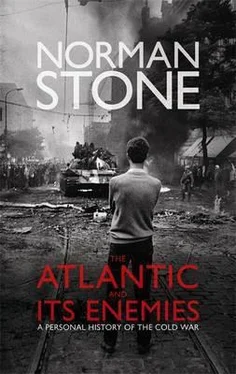Roosevelt had had much trouble with the Supreme Court in the later 1930s. Johnson found that he could get around this, because he had an astute legal ally, Abe Fortas, and he could in effect ‘pack’ the Court. States’ rights were overborne, and so too, on occasion, were the provisions of Congress. But Medicare and Medicaid followed, paying for the elderly and the poor, both becoming much more expensive than any other system of health care, and yet also excluding many millions of people. A Mass Transit Act committed $375m of federal funds to subsidize public transport, particularly railways. A Higher Education Act gave funds for the education of the poor, in 1965, and in 1966 a Demonstration Cities Act gave funds for the abolition of ghettoes; a Housing and Urban Development Act followed, in 1968. Urban transport, landscaping, etc. were to be supported, at first in six cities, then in others. It all meant bureaucratic expansion, the more so when large areas were declared environmentally secured, and the arts (‘National Endowment for the Humanities and the Arts’) came up as well. Under Johnson, the educational spending rose from $2.3bn to $10.8bn and health spending from $4.2bn to $13.9bn. The costs of all this grew hugely, from $5.5bn in 1964-5 to $144bn by 1993. The ‘disadvantaged’ (as the poor, given the odd American addiction to euphemism, were now called) saw their share of overall spending rise from $12.5bn to $24.6bn in the sixties. But it all went together with spending on defence. That had risen tenfold since 1949, reaching $114.5bn by 1979 and running at about 4 or 5 per cent of GNP. America was heading for a great deficit problem, and in the sixties was already producing considerable inflation as the paper dollars were churned out. ‘The Great Society’ ran very sour, and for it all ‘Vietnam’ became the symbol. If it had not existed, it would have had to be invented. It too, despite the legend of JFK, had started with him.
The Vietnam problem had emerged in the first place from the collapse both of France and of Japan. There had been other, similar cases — similar, at least, in the sense that they all looked the same if you judged things with the wrong criteria, as, increasingly, number-obsessed American managers, with no particular knowledge, were inclined to do. The European empires in Asia had collapsed, but the American record in the area had not been bad — not at all: Japan, Taiwan and South Korea were starting to flourish, and, in the Philippines, American military intervention had quite successfully put down a Communist rebellion. The British had done the same in Malaya, had in fact had a legendary success in doing so. Why Vietnam was different is still an interesting question. For a start, it was not a unity, but until 1954 a French colony, acquired in the later nineteenth century, as a sort of failed stepping stone to China. The complications even began with the name. The French had called it Annam, a Chinese word meaning ‘conquered place’; Cochinchine, as the south was known, came from a Portuguese word that was itself a misreading of the Chinese characters for ‘Vietnam’. The French also used Tonkin for the northern part, and stressed the divisions, so as to rule more easily; and there were two associated countries, Laos and Cambodia, the whole being known as French Indo-China. Indian and Chinese influences had shaped the country, and Buddhism of various types reigned, but Catholicism had also been brought to bear. There was even a Moslem minority, the Chams, who spoke a language that was the link between the version of Thai spoken in southern China and Indonesian. There was rice, there was rubber, and the geography, from the great Mekong Delta in the south to the mist-swathed mountains of the centre, was very varied. Much of the trade was in the hands of the Chinese minority, who had a symbiotic relationship with river pirates who managed to develop a religious sect all their own. The French managed things easily enough in the days when they had the machine-guns and the Vietnamese did not. There was even an emperor, supplying picturesque legitimacy to the French presence. Then the Vietnamese acquired machine-guns.
They also acquired, and again courtesy of French lessons, a leader of genius who had much the same understanding as Mao had had, as to how technique from the West could be used to subvert the West. The Comintern had its adventurers, men and women who went from language to language and country to country stirring up trouble. Ho Chi Minh was the strangest. He started out with the usual twixt-and-between origins of so many Comintern stalwarts: his father, son of a concubine, nevertheless a mandarin; his schooling, from a French Foreign Legionary with a foul temper; an escape, as stoker, to France, where there was a spell of market-gardening, and then London, where he assisted the great Escoffier in making pastry for the Savoy. In the First World War the French shifted 100,000 Annamites to dig trenches, and Ho picked up Marxism from two Hungarian-Jewish brothers who ran a hostel. The French socialists split in 1920 as to whether they should link up with the victorious Communists in Russia. Ho attended the conference that decided in favour, and signed the document. Then it was the Oriental Workers University in Moscow, where the Comintern taught its people how to take over countries, what were the levers of real power. Ho then moved east — Bangkok as a Buddhist monk, Hong Kong as a cigarette-seller. There, the police picked him up, and he had to be released when appeal was made on his behalf by a prominent British left-wing figure, Sir Stafford Cripps. In 1941, when the Japanese invaded Vietnam, he walked back in. This extremely thin, ascetic, chain-smoking figure with his TB and malaria, his multiple pseudonyms (of which Ho Chi Minh was one, and meant ‘bringer of light’) soon met another clever product of French Marxism, Vo Nguyen Giap, who turned out to have a superb talent for underground warfare. In May 1941, in a small hut, with bamboo tables, they staged the ‘eighth plenum’ of the Vietnamese Communist Party. Ho, chairman, sat on a wooden box and drafted the introductory statements, which are not inflammatory reading. The new organization, essentially popular-front Communist, had the name Viet Nam Doc Lap Dong Minh , or Vietnamese Independence League. It was shortened to ‘Vietminh’ and was then known as ‘Vietcong’.
In 1945, when the Japanese collapsed, Ho Chi Minh could claim quite simply to be the leader of a nationalist resistance. Giap had organized resistance cells among the peasantry, five to a cell, and, in accordance with the usual practice, did not reveal cells’ existence to other cells. They just took their orders from an unknown source — that committee meeting in a bamboo hut. Having used non-Communists in the resistance, Ho and Giap set about eliminating them when the Japanese surrendered (including all Trotskyists, who had illusions that there might be a ‘native’ revolution independent of Moscow). Ho knew very well that help from Moscow would be decisive, but here, as a pawn in Moscow’s game, he needed to be careful. After all, the French were far more important, as potential allies, than any Vietnamese Communists and until 1947, when the Communists were expelled from the Paris government, Ho was required to co-operate with the French. They were very clumsy, not appreciating that their end of empire was upon them, and Ho gained allies. In 1949 China became Communist, and help was forthcoming from that quarter. It gave the Vietminh a commanding lead. By 1952 the French were facing an extremely difficult war, with brittle allies and uncertain American support; in May 1954 they lost a final battle at Dien Bien Phu, in the north. No doubt if Ho had been left to his own devices, he would have gone on to conquer the south. However, in 1954 the Soviets, anxious to spare France in case she signed up to the European Defence Union, pushed for negotiations at Geneva, and a South Vietnamese state came into existence. Ho’s North Vietnam established itself in the usual way, with a million refugees, mainly Catholic, fleeing from collectivized agriculture and the one-party militarized state. There were 100,000 executions.
Читать дальше












![Edward Ellis - Adrift on the Pacific - A Boys [sic] Story of the Sea and its Perils](/books/753342/edward-ellis-adrift-on-the-pacific-a-boys-sic-s-thumb.webp)